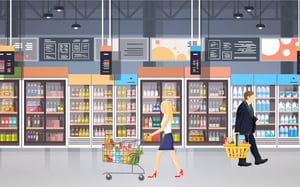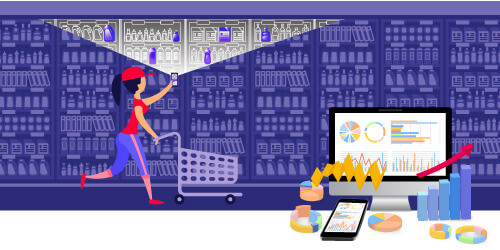It’s a Thursday. 5:30 pm. You’ve just knocked off from work and are on your way home when your partner calls to tell you that you’re out of milk and need to grab some en route. It’s the last thing you want to do. Pulling into the parking lot of your local supermarket, you cringe at the thought of navigating through the bustling aisles.
You can imagine yourself getting to the dairy section only to find that the 2% is sold out – again. And then having to wait in the checkout line for 20 minutes only to find that the price of whole milk went up, and there wasn’t a label on the shelf to let you know.
Anticipating the worst, you exit your vehicle and head in-store.
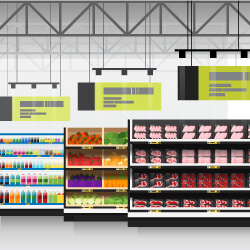
But everything looks different. Better!
From the fresh flowers for sale gracing the spacious entryway to the neat rows of waist-high shelves guiding the checkout queues to the tellers, there’s a new sense of organisation in the store. It’s a feeling of refined arrangement.
As you navigate the aisles, you notice that things have changed – a lot.
Once-jumbled shelves now make more sense. Complimentary products are closer to one another. There appears to be a much more pleasant flow to the store, and things seem more organised.
As you approach the dairy section, you smile in delight at the fact that it is now fully stocked – 2% milk front and centre, within easy reach, and surrounded by rows of items you need but probably would’ve forgotten to pick up.
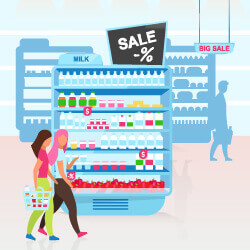
Eggs, yoghurt, bread, and coffee beans – on special
and perched on a stand – have all been placed
neatly alongside this new dairy wonderland.
You grab the milk, six eggs and some artisanal bread, eager to please your partner with this surprise when you get home.
Anticipating a long queue and an unpleasant wait, more delight awaits as you enter the snaking check-out aisle.
In between admiring the speed with which the line shortens and the cleverly placed promotional products at the end of each row of shelves, you take advantage of the convenience afforded by the litany of strategically positioned items surrounding you as you wait.

Take advantage of the convenience.
You pop a chocolate bar into your basket, add some candy for the kids and a pack of AA batteries you keep forgetting to pick up before greeting the teller, paying and heading for the exit.
On the way home, you smile to yourself, having been pleasantly surprised at an impressive shopping experience and that you enjoyed picking up the milk for once. In fact, you look forward to the next time you need to do it.
You've just experienced what it's like to shop at a store that implements a category management solution.
Using data to take your retail shopping experience to the next level
You might not know this, but there is far more to retail shopping than meets the eye. Retailers don't place products on shelves and hope that you'll somehow find your way to them.
You’ve probably heard about that old ‘trick’ used for generations by retailers: Place a product at eye level, and people are much more likely to buy it. Well, it’s true. It's also only one of many techniques that retailers use to only to boost revenue but also to improve your shopping experience.
An improved in-store experience keeps you coming back, aims to increase your loyalty and - you guessed it - boosts revenue.
So what is category management all about? While the bottom line used to be the primary goal among retailers, that's no longer the case.
Today, we know that shoppers are more sensitive toward negative experiences and are focused on finding stores that give them exactly what they want instead of the closest or most affordable option.
Joerg Koesters, global head of Retail Marketing at SAP agrees in his article for Forbes. He writes of the three types of shoppers when it comes to grocery shopping, which ties in with our example.
To paraphrase him, you either want to complete your purchase as quickly as possible, look for the best price to maximise your money spent or be inspired by your shopping experience and discover new products.
Below, we delve into how category management affects your shopping experience as an everyday customer. We also reveal some of the secrets and hacks retailers use to ensure you receive the most optimised experience possible.
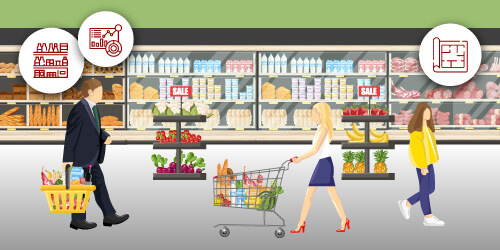
Category management - the science behind the shopping
From floor layouts to days of supply, pricing variability to seasonal stock levels, premium items to house brands, category management helps retailers to optimise their product lines while taking the shopper’s retail experience to the next level.
Category management is built around optimising more than simply the retailer’s ability to deliver quality product assortments to their customers. The industry has evolved to take a data-driven approach to optimisation, transforming how we shop and offering a modern, convenient retail shopping experience like never before.
It's all about the data, baby
Category management comes down to pure numbers - OK, and trends, patterns, buying preferences, behaviours, pricing levels, demographics and much, much more.
At the end of the day, your shopping experience is defined by cold, hard facts, AKA data.
This data feeds into category management software systems where it is used to determine precisely which store layouts, stock levels, product varieties and even shelf fixtures will deliver the perfect mix of elements for the shopper.
Retailers are always gathering this data up from their shoppers from the moment they set foot in-store, to when they pay and leave. This information is then used to enhance everything about the store - from which products are laid out onto shelves to how the aisles are arranged and how quickly you’re able to get in and out.
Here are some of the more noticeable benefits that category management has for you, the shopper.
-
Optimised store layouts
Have you ever wondered why some shops have long, tall, seemingly endless aisles while others have far shorter rows of goods, neatly arranged to allow you to pass in and out with ease?
It’s not down to floor manager preference - it’s category management.
Floor planners are responsible for selecting a store layout that suits your needs as a shopper. From minimising congestion in certain areas during peak shopping hours to encouraging a flow that prevents you from running back and forth between aisles, category management uses data to ensure that floor layouts are optimised for ease of flow and your shopping pleasure.
-
Out of stocks are taken care of
Nothing beats the frustration of visiting a store only to find that they’ve run out of stock on a product - especially as it always seems they’ve exhausted their inventory on that ONE item you’ve visited the store for.
Category management uses short and long-term trends to tell the store manager exactly how many days of supply (ie. how much time) he has before a particular item will clear from a shelf.
This means that retailers won’t have to wait for something to run out before ordering more or to stockpile a massive hoard of items. With category management, they’re able to essentially predict when something will run out and replace it accordingly. That means you can visit a store knowing that it’ll have what you need when you need it.
-
Wider, more attractive product selections
It’s no coincidence that some items take up three-quarters of a shelf, while others only get one or two spots.
No, this isn’t down to suppliers paying for space - although that does happen. Or because the more expensive ones will rake in more revenue.
This happens because category management has used that crucial retail data to figure out the perfect, delicate balance that allows you to enjoy just the right amount of options, while still having access to the premium or economy products.
This way, you’re spoiled for choice without having to browse through endless lines of items you and your fellow shoppers would never buy.
Tobias Wachinger, Christian Weber and Stefano Zerbi back this up in a McKinsey & Company white paper titled Analytical Assortment Optimization, pointing out that retailers benefit too.
“Developing a more analytical assortment management process pays off (Wachinger, Weber & Zerbi, 2019), as the insights gained can lead to improvements across several areas. These improvements can significantly enhance financial performance.”
-
Complementary products in the right place at the right time
Trying to figure out exactly where to find certain products in a big store can sometimes feel like an impossible task. Yet, somehow, when you grab one item, another one (one that you didn’t realise you needed, but actually do) seems to magically appear right next to it!
Coincidence? Nope - it’s down to category management.
Category management allows retailers to strategically place complementary products next to one another, making retail shopping easier and more convenient. It even takes into account seasons, local preferences and popularity.
ConclusionThe next time you visit a store, pay a little more attention to why things are where they are and how they influence your overall shopping experience. You may not know it, but enormous effort and careful planning have gone into how everything has been laid out and selected to suit your taste and needs.
Whether you’re saving five minutes at a time for every visit you pay to the store (which, for the average twice-weekly shopper, can save up to five hours in a year) or enjoying the convenience of having access to your favourite – always in-stock – product lines, category management is the why behind the smile on your face.
Now that you know why the milk isn’t where it used to be, you can ‘shop easy’ knowing that your favourite local retailer has made a smart investment in a category management solution that helps you to enjoy your retail shopping experience like never before.


